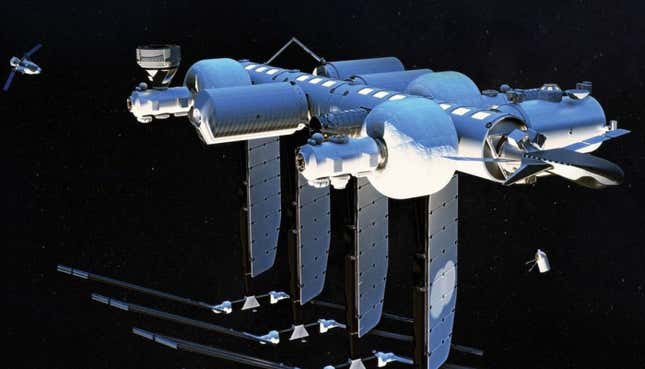
The scheduled retirement of the International Space Station in 2030 has put NASA under a lot of pressure to secure a replacement. The space agency has tapped several private companies to develop a solution, with a collaborative project from Blue Origin and Sierra Space recently passing a critical milestone.
NASA, along with members from Sierra Space and Blue Origin, performed the Orbital Reef System Definition Review (SDR) in June and July. The space agency assessed the companies’ plan as being both feasible and achievable, which means the project can now graduate to the design phase.
“This SDR moves Orbital Reef forward,” Brent Sherwood, senior vice president of Advanced Development Programs at Blue Origin, said in a Sierra Space statement. “We are meeting the needs of both the commercial marketplace and NASA’s requirements. Orbital Reef will change the game for human space flight in Earth orbit.”
The proposed space station is being developed under NASA’s Commercial Low-Earth Orbit Development Program (CLD). In addition to Blue Origin and Sierra Space, the collaborative Orbital Reef project includes Amazon Supply Chain, Amazon Web Services, Arizona State University, Boeing, Genesis Engineering Solutions, and Redwire Space. Jeff Bezos-led Blue Origin received $130 million in funding from NASA, while Colorado-based Sierra Space managed to secure $1.4 billion in funding for the project last year. Axiom Space, NanoRacks, and Northrop Grumman are developing their own space stations under NASA’s CLD.
A key goal of the recently concluded SDR was to establish the functional baselines for Orbital Reef. NASA concluded that the proposed space station meets functional and performance requirements and that the system architecture, including the interoperability of its components, is sound. With this vote of confidence, Blue Origin and Sierra Space will now further develop Orbital Reef’s system architecture and design.
Described as a “mixed-used business park,” Orbital Reef is being designed to house 10 astronauts in a volume of space comparable to the ISS interior. The station will host science experiments in a microgravity environment, provide a platform for developing space tech, entertain space tourists, and possibly serve as the venue for upcoming film shoots. Construction of Orbital Reef is slated to begin in 2026, with the station becoming operational by 2027.
Sierra Space CEO Tom Vice said the new space station will help to extend “our factories and cities into space.” It’s not “solely about tourism,” he added—it’s “about unlocking the next great discoveries using the microgravity factories that we will build just 250 miles above the Earth’s surface.”
Sierra Space recently announced its plans to build the “world’s first fully integrated commercial human spaceflight center and astronaut training academy.” The academy will train three different types of astronauts for trips and missions to Orbital Reef. Sierra Space is also developing a spaceplane called Dream Chaser, which is designed to carry 12,000 pounds (5,443 kilograms) to low Earth orbit. Dream Chaser could be ready by 2026, performing regular cargo missions to Orbital Reef and possibly the ISS.
More: Russian Cosmonaut Forced to Abandon Spacewalk Due to Spacesuit Power Malfunction.